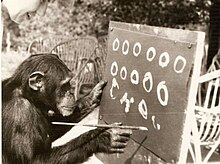
Back Intel·ligència dels primats Catalan شناخت نخستیها Persian Inteligência em primatas Portuguese Trí khôn ở linh trưởng Vietnamese
This article needs additional citations for verification. (March 2012) |


Primate cognition is the study of the intellectual and behavioral skills of non-human primates, particularly in the fields of psychology, behavioral biology, primatology, and anthropology.[1]
Primates are capable of high levels of cognition; some make tools and use them to acquire foods and for social displays;[2][3] some have sophisticated hunting strategies requiring cooperation, influence and rank;[4] they are status conscious, manipulative and capable of deception;[5] they can recognise kin and conspecifics;[6][7] they can learn to use symbols and understand aspects of human language including some relational syntax, concepts of number and numerical sequence.[8][9][10]
- ^ Michael Tomasello; Josep Call (1997). Primate cognition. Oxford University Press. ISBN 978-0-19-510624-4.
- ^ Boesch C, Boesch H (1990). "Tool use and tool making in wild chimpanzees". Folia Primatologica; International Journal of Primatology. 54 (1–2): 86–99. doi:10.1159/000156428. PMID 2157651.
- ^ Westergaard GC, Lundquist AL, Haynie MK, Kuhn HE, Suomi SJ (June 1998). "Why some capuchin monkeys (Cebus apella) use probing tools (and others do not)". Journal of Comparative Psychology. 112 (2): 207–211. doi:10.1037/0735-7036.112.2.207. PMID 9642788.
- ^ de Waal FB, Davis JM (2003). "Capuchin cognitive ecology: cooperation based on projected returns". Neuropsychologia. 41 (2): 221–228. CiteSeerX 10.1.1.496.9719. doi:10.1016/S0028-3932(02)00152-5. PMID 12459220. S2CID 8190458.
- ^ Parr LA, Winslow JT, Hopkins WD, de Waal FB (March 2000). "Recognizing facial cues: individual discrimination by chimpanzees (Pan troglodytes) and rhesus monkeys (Macaca mulatta)". Journal of Comparative Psychology. 114 (1): 47–60. doi:10.1037/0735-7036.114.1.47. PMC 2018744. PMID 10739311.
- ^ Parr LA, de Waal FB (June 1999). "Visual kin recognition in chimpanzees". Nature. 399 (6737): 647–648. Bibcode:1999Natur.399..647P. doi:10.1038/21345. PMID 10385114. S2CID 4424086.
- ^ Fujita K, Watanabe K, Widarto TH, Suryobroto B (1997). "Discrimination of macaques by macaques: The case of sulawesi species". Primates. 38 (3): 233–245. doi:10.1007/BF02381612. S2CID 21042762.
- ^ Call J (June 2001). "Object permanence in orangutans (Pongo pygmaeus), chimpanzees (Pan troglodytes), and children (Homo sapiens)". Journal of Comparative Psychology. 115 (2): 159–171. doi:10.1037/0735-7036.115.2.159. PMID 11459163.
- ^ Itakura S, Tanaka M (June 1998). "Use of experimenter-given cues during object-choice tasks by chimpanzees (Pan troglodytes), an orangutan (Pongo pygmaeus), and human infants (Homo sapiens)". Journal of Comparative Psychology. 112 (2): 119–126. doi:10.1037/0735-7036.112.2.119. PMID 9642782.
- ^ Gouteux S, Thinus-Blanc C, Vauclair J (2001). "Rhesus monkeys use geometric and nongeometric information during a reorientation task". Journal of Experimental Psychology: General. 130 (3): 505–519. doi:10.1037/0096-3445.130.3.505. PMID 11561924.
© MMXXIII Rich X Search. We shall prevail. All rights reserved. Rich X Search